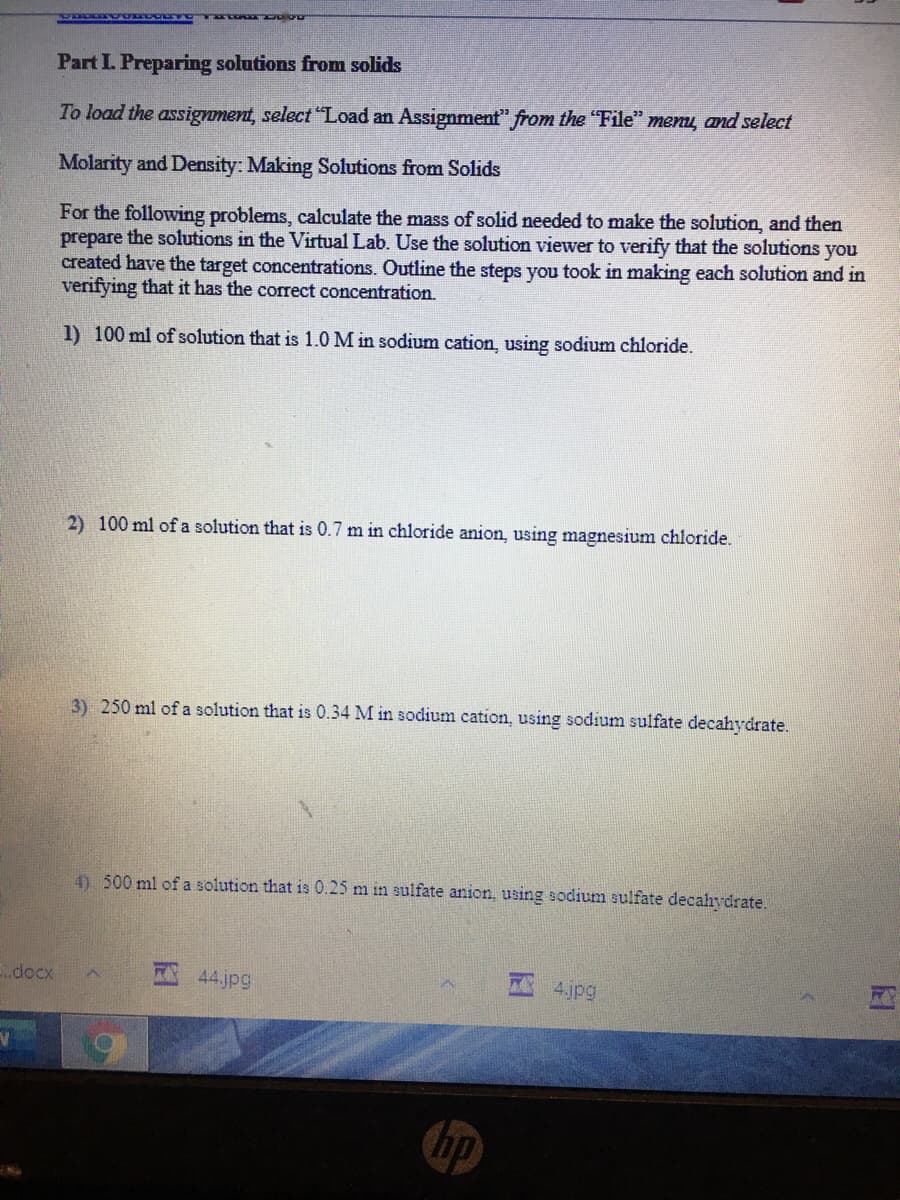To load the assignment, select "Load an Assignment" from the "File" menu, and select Molarity and Density: Making Solutions from Solids For the following problems, calculate the mass of solid needed to make the solution, and then prepare the solutions in the Virtual Lab. Use the solution viewer to verify that the solutions you created have the target concentrations. Outline the steps you took in making each solution and in verifying that it has the correct concentration. 1) 100 ml of solution that is 1.0 M in sodium cation, using sodium chloride. 2) 100 ml of a solution that is 0.7 m in chloride anion, using magnesium chloride. 3) 250 ml of a solution that is 0.34 M in sodium cation, using sodium sulfate decahydrate. 4) 500 ml of a solution that is 0.25 m in sulfate anion, using sodium sulfate decahydrate.
To load the assignment, select "Load an Assignment" from the "File" menu, and select Molarity and Density: Making Solutions from Solids For the following problems, calculate the mass of solid needed to make the solution, and then prepare the solutions in the Virtual Lab. Use the solution viewer to verify that the solutions you created have the target concentrations. Outline the steps you took in making each solution and in verifying that it has the correct concentration. 1) 100 ml of solution that is 1.0 M in sodium cation, using sodium chloride. 2) 100 ml of a solution that is 0.7 m in chloride anion, using magnesium chloride. 3) 250 ml of a solution that is 0.34 M in sodium cation, using sodium sulfate decahydrate. 4) 500 ml of a solution that is 0.25 m in sulfate anion, using sodium sulfate decahydrate.
World of Chemistry, 3rd edition
3rd Edition
ISBN:9781133109655
Author:Steven S. Zumdahl, Susan L. Zumdahl, Donald J. DeCoste
Publisher:Steven S. Zumdahl, Susan L. Zumdahl, Donald J. DeCoste
Chapter15: Solutions
Section: Chapter Questions
Problem 63A
Related questions
Question
please answer me for 3 and 4 thanks

Transcribed Image Text:Part L Preparing solutions from solids
To load the assignment, select "Load an Assignment" from the "File" menų, and select
Molarity and Density: Making Solutions from Solids
For the following problems, calculate the mass of solid needed to make the solution, and then
prepare the solutions in the Virtual Lab. Use the solution viewer to verify that the solutions you
created have the target concentrations. Outline the steps you took in making each solution and in
verifying that it has the correct concentration.
1) 100 ml of solution that is 1.0 M in sodium cation, using sodium chloride.
2) 100 ml of a solution that is 0.7 m in chloride anion, using magnesium chloride.
3) 250 ml of a solution that is 0.34 M in sodium cation, using sodium sulfate decahydrate.
4) 500 ml of a solution that is 0.25 m in sulfate anion, using sodium sulfate decahydrate.
.docx
44.jpg
4.jpg
hp
Expert Solution
This question has been solved!
Explore an expertly crafted, step-by-step solution for a thorough understanding of key concepts.
This is a popular solution!
Trending now
This is a popular solution!
Step by step
Solved in 6 steps

Knowledge Booster
Learn more about
Need a deep-dive on the concept behind this application? Look no further. Learn more about this topic, chemistry and related others by exploring similar questions and additional content below.Recommended textbooks for you

World of Chemistry, 3rd edition
Chemistry
ISBN:
9781133109655
Author:
Steven S. Zumdahl, Susan L. Zumdahl, Donald J. DeCoste
Publisher:
Brooks / Cole / Cengage Learning

Chemistry: Principles and Practice
Chemistry
ISBN:
9780534420123
Author:
Daniel L. Reger, Scott R. Goode, David W. Ball, Edward Mercer
Publisher:
Cengage Learning

Introductory Chemistry: An Active Learning Approa…
Chemistry
ISBN:
9781305079250
Author:
Mark S. Cracolice, Ed Peters
Publisher:
Cengage Learning

World of Chemistry, 3rd edition
Chemistry
ISBN:
9781133109655
Author:
Steven S. Zumdahl, Susan L. Zumdahl, Donald J. DeCoste
Publisher:
Brooks / Cole / Cengage Learning

Chemistry: Principles and Practice
Chemistry
ISBN:
9780534420123
Author:
Daniel L. Reger, Scott R. Goode, David W. Ball, Edward Mercer
Publisher:
Cengage Learning

Introductory Chemistry: An Active Learning Approa…
Chemistry
ISBN:
9781305079250
Author:
Mark S. Cracolice, Ed Peters
Publisher:
Cengage Learning

Chemistry
Chemistry
ISBN:
9781305957404
Author:
Steven S. Zumdahl, Susan A. Zumdahl, Donald J. DeCoste
Publisher:
Cengage Learning

Chemistry: An Atoms First Approach
Chemistry
ISBN:
9781305079243
Author:
Steven S. Zumdahl, Susan A. Zumdahl
Publisher:
Cengage Learning
